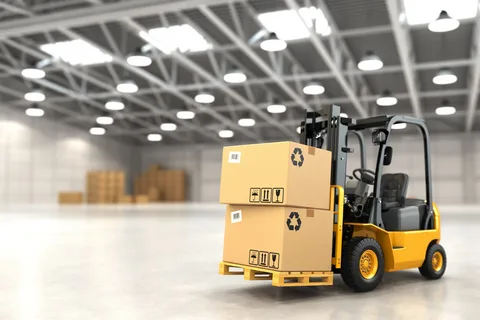Forklifts, renowned for their role as the workhorses of material handling, play a pivotal function across various industries. However, there exists a well-kept secret, an attachment that has the potential to transform their utility dramatically, while simultaneously enhancing workplace safety. This revelation lies in the world of forklift jibs, a versatile and ingenious addition that can significantly alter the way heavy loads are managed. In this comprehensive guide, the focus will be on navigating through the realm of forklift jibs, encompassing the understanding of various types, their unique purposes, intricacies of load capacity, the enhancement of safety aspects, the requisite maintenance practices, and methods to identify wear and tear.
Understanding Forklift Jibs
What Are Forklift Jibs?
The essence of forklift jibs, also referred to as forklift boom attachments, involves functional extensions engineered to amplify the lifting capabilities of a forklift. These attachments are available in multiple configurations, including fixed, telescopic, and articulating designs, each meticulously tailored to address distinct material handling requirements. Some of the common forklift jib attachments are:
Extension jib
Adjustable swing jib
Economy jib
Fixed jib
Towball jib
Heavy duty economy jib
Heavy duty extension jib
Short extension jib
The primary objective of forklift jibs is to empower forklifts to reach, hoist, and transport heavy loads that would otherwise pose significant challenges.
Why Should You Have Forklift Jibs?
Why should you consider investing in forklift jibs? The answer is remarkably simple: they provide unrivaled versatility in material handling tasks. Forklift jibs can extend your forklift’s reach, enabling you to access confined spaces or lift bulky items with remarkable ease. Whether you’re dealing with lengthy pipes, hefty machinery, or oddly-shaped loads, forklift jibs offer a dynamic solution that significantly improves your operational efficiency.
Key Industries Benefitting from Forklift Jibs
Forklift jibs find extensive application in various sectors and industries where heavy lifting and precision material handling are essential. Some of the key sectors include construction, manufacturing, warehousing, logistics, shipping, agriculture, and mining. In construction, jibs assist in lifting heavy building materials, while manufacturers rely on them for efficient production processes. Warehouses and logistics companies utilise jibs to optimise storage and loading. In agriculture, jibs handle bulk crops, and in mining, they manage substantial mining equipment. Essentially, any industry requiring efficient, safe, and versatile heavy-load handling is likely to benefit from forklift jibs.
What’s the Load Capacity of Forklift Jibs?
The matter of load capacity stands as a pivotal consideration within the scope of forklift jibs. The capacity to bear loads varies markedly among the various types and designs of forklift jibs. Fixed jibs, celebrated for their sturdiness, offer high load capacities, frequently ranging from 2000 to 6000 pounds, or approximately 900 to 2700 kilograms, if not more. Telescopic jibs provide a more flexible range of capacities, typically aligning with the aforementioned weight spectrum. Articulating jibs, known for their adaptability, often surpass the 2000-pound threshold. To ensure the safety and efficiency of operations, rigorous adherence to the specific jib’s specifications and the recommended weight limits remains paramount.
Elevating Safety in the Workplace
How Forklift Jibs Enhance Safety
Safety, rightfully, remains an overarching priority within any warehouse or workplace. In this context, forklift jibs assume a pivotal role. By extending the forklift’s reach and reducing the necessity for operators to maneuver in tight or restricted spaces, these attachments mitigate the risk of accidents and injuries. They facilitate precision handling, reducing the likelihood of collisions and mishandling of loads. This not only safeguards the workforce but also acts as a deterrent against costly damage to both goods and equipment.
Do Forklift Jibs Require Maintenance?
Maintenance proves to be a non-negotiable facet in ensuring the continued performance and safety of forklift jibs. Regular maintenance practices typically involve a comprehensive inspection process aimed at identifying early indicators of wear and tear. This includes meticulous lubrication of moving components to alleviate friction, as well as a meticulous examination of various components to detect signs of looseness or damage. Adherence to the manufacturer’s maintenance guidelines and prescribed schedules is imperative to maintain forklift jibs in optimal working condition.
Signs of Wear and Tear
Proactive vigilance in detecting signs of wear and tear is critical for safeguarding the longevity and safety of forklift jibs. This involves a vigilant watch for worn or frayed cables, securely fastened bolts, hydraulic leakages, or any signs of deformation in structural components. Promptly addressing any indications of wear and tear through maintenance or, when necessary, replacement, is paramount to prevent accidents and maintain optimal operational efficiency.
In summary, forklift jibs emerge as a dynamic and safety-enhancing addition to an organisation’s material handling toolkit. Their remarkable capacity to extend the reach of forklifts, enhance load-bearing capabilities, and mitigate the risk of accidents elevates them to the status of indispensable tools in any warehouse or worksite. The strategic integration of forklift jibs, complemented by stringent maintenance and vigilant monitoring for wear and tear, leads to consistently optimal performance and safety. For those seeking to enhance the efficiency and safety of their material handling operations, the inclusion of forklift jibs promises substantial benefits and warrants serious consideration.







